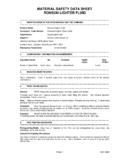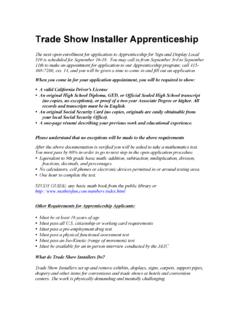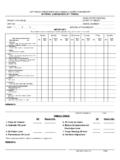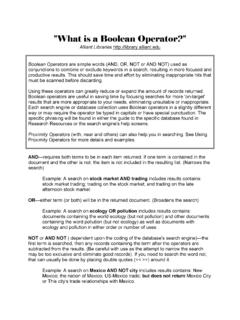Transcription of Class III Operator Safety Training - Local 510 Sign …
1 Class III Operator Safety Training Manual & Exam Introduction Note: The term pallet truck is used to represent all types of powered hand pallet trucks and Class III tuggers. This Training program is designed to assist you in becoming a trained and authorized lift truck Operator . The powered hand pallet truck is a critical piece of equipment to a company that needs to move materials from point A to point B. It can move thousands of pounds of products in a matter of minutes. The same job performed by manual labor could take hours or days. Imagine in your area how difficult it would be to do the same amount of work without a lift truck.
2 Information included in this pamphlet does not include all the Training requirements or Safety features of the program. This Training program must include the CD, VHS or Web based Training , this manual, hands-on Training , an Operator 's evaluation and employer certification. Training should also include the Operator 's and Owner's Manual(s) and the attachment manual(s) for the specific lift trucks and attachment the employee will be certified to operate. Who can use a lift truck? The Occupational Safety & Health Administration (OSHA) has very clear standards (29 CFR (1)(6)) that employees must follow.
3 The employer shall certify that each Operator has been trained and evaluated as required. Prior to the employer certifying the Operator ; the Operator must receive classroom type Training , hands-on Training , and an evaluation. Do not operate a pallet truck unless you have been trained, authorized, and employer certified on the specific Class of lift truck. Once you are a certified pallet truck Operator , you are responsible for always following the Safety procedures outlined in this Training , the truck manufacturers Owner's and Operator 's Manual, and your companies policies and procedures.
4 Looking for Hazards Making the workplace safe involves everyone. Keep an eye open for hazards and report them immediately to your supervisor. This chart illustrates that Safety hazards can be anywhere. Operating Instructions, warnings and precautions Prior to operating a pallet truck you should have reviewed the Operator /Owner's Manual for that specific truck. The manual provides specific information for the operation of that specific pallet truck. There may also be specific warnings or precautions for pallet truck operations. These warning or precautions might be found in the Operator 's and owner's manual(s), attachment manual(s), or posted on the lift truck(s).
5 Differences between the lift truck and the automobile A pallet truck is a mobile, powered propelled truck used to carry, push, pull, and lift material. Pallet trucks are significantly different from automobiles. Pallet trucks are equipped with forks designed to move material weighing several thousand pounds. Automobiles are not designed for this purpose. Automobiles are not designed to carry heavy loads at one end of the vehicle. Pallet truck steering is from the rear while automobile steering, in most cases, is front wheel drive. To learn more about the differences between the pallet truck and the automobile, please refer to the Truck Related Topics Section of the Operator Safety Training Program.
6 Controls The specific controls and instrumentation of your pallet truck should be discussed during the hands-on portion of the Training and the specific trucks Operator 's and Owner's Manual. Capacity All pallet truck capacities are required to be identified by a securely fastened and legible nameplate. The nameplate contains vital information about the truck's capacity. Generally, a pallet truck can lift a load up to six inches and may have a capacity as high as 8,000 pounds. If the pallet truck is modified in any way or has an attachment added, you must have prior written approval from the lift truck manufacturer.
7 The nameplate will show the maximum weight the pallet truck can lift. Nameplate for electric trucks MODEL - The model of the truck SERIAL NO. - The frame number of the truck. MAST - Not Applicable BACK TILT - Not Applicable ATTACH -The attachment that is approved for this truck TYPE - The type of power needed to operate the truck as designed and Safety rating. VOLTAGE - This is the operating voltage of the truck. BATTERY TYPE - This defines the minimum Safety rating for the battery for this specific truck. FRONT TREAD - In both metric and inches. FRONT TREAD TIRE SIZE - The required tire size for both axles to meet the stability requirements as the truck was designed.
8 TRUCK WEIGHT W/O BATTERY - The approximate weight of the truck without the battery including attachment weight. In both metric and pounds. BATTERY WEIGHT MIN/MAX The minimum and maximum weight of the battery that can be installed in this truck to meet the design stability requirements. In both metric and pounds. RATED CAPACITY WITH VERTICAL MAST EQUIPPED AT MAX. LIFT HEIGHT -Not Applicable Stability Many pallet trucks are like a tricycle, with only three wheels. If the pallet truck is turned too quickly or stopped abruptly, the truck can become unstable. If this happens you can lose control or drop the load.
9 Center of Gravity: Simply put, it is the place at which an object will balance on a single point. Common sense dictates that the Center of Gravity is usually at the center of an object. But look at the diagram below: Notice the shape of these loads alter their Center of Gravity Maneuvering Driving the pallet truck at excessive speed can result in loss of control, causing the vehicle to skid, tip over, or fall off a loading dock or other elevated surfaces. It is important to follow these basic rules in maneuvering the pallet truck: When making a turn, reduce speed to a safe level, turn steering wheel in a smooth, sweeping motion.
10 Only handle stable and safely arranged loads. Never move a load outside the truck's rated capacity. Pallet trucks shall not be driven up to anyone standing in front of a bench or fixed object. Observe all traffic regulations including the facility speed limits. Keep at least three truck lengths away from other trucks going in the same direction. Visibility When operating a pallet truck, you must understand the potential hazards of obstructed visibility. There are many things that could impede visibility, such as: loads on forks, lighting, racks, building columns, blind intersections, tractor trailers and pedestrians to name a few.









